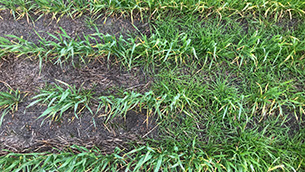Same results with new liquid herbicide at Mingenew
About
-
Category
- Grower Stories
- Product News
-
Date
24 October, 2019
-
Location
Mingenew, WA
-

About
Category
- Grower Stories
- Product News
Date
24 October, 2019
Location
Mingenew, WA
A switch to trialing the new liquid formulation of the benchmark pre-emergent herbicide, Sakura® this season has delivered the same good results for annual ryegrass control at the Duane family farm near Mingenew.

Image: Nick and Ty chat about the same good results for annual ryegrass control in wheat being achieved with the new liquid formulation of the the pre-emergent herbicide, Sakura, on the family’s Mingenew property.
Nick and Bec Duane, together with Nick’s parents, Andy and Helen, crop 6500-7000 hectares to wheat, lupins, canola and, occasionally, barley at their ‘Yandy Farms’ property.
They follow a wheat-lupins-wheat-canola rotation on sandplain soils and a wheat-wheat-canola-wheat-wheat-lupins program on heavier country.
Nick said prior to first using the water dispersible granule (WG) formulation of Sakura on the property, Treflan® and Logran® herbicides were primarily used for grass control.
“We started from a low base in terms of ryegrass numbers, but we weren’t making any headway. We were running into Group B and A herbicide resistance,’’ Nick said.
“In the first year with Sakura in select paddocks, we managed to patch out the worst ryegrass areas. Sometimes we applied Treflan and Logran with it in front of the seeder.
“Our best results with Sakura have been when we have applied it into dry conditions, dry-sown and then received sufficient follow-up rain.
“We then dropped Treflan out for several reasons including less crop damage, the ability to dry-sow hopefully giving us a yield benefit, and the cost saving enabling us to put Sakura under all our wheat.’’
The Group K herbicide is applied to 80-90% of the wheat program and incorporated with an Ausplow DBS bar, while a John Deere air drill is used for the remainder on country that is deep ripped and spaded.
“Our ryegrass numbers have dropped significantly,’’ Nick said.
“The only areas where we haven’t won the battle are hot spots, like gravelly areas that can have blowouts. We get those areas with Roundup Ready® canola or by crop-topping lupins. We also windrow burn and/or paddock burn at times.
“We think Sakura is also helping against brome grass, barley grass and wild oats. We have some brome grass on the sandplain, where we add Monza® with Sakura or spray it early post-emergent.’’

Image: Bayer Commercial Sales Representative Ty Gronow and Mingenew grower Nick Duane discuss the application of the new Sakura Flow liquid pre-emergent herbicide through the family’s John Deere 4940 self-propelled sprayer.
The new Sakura Flow suspension concentrate (SC) formulation now available is applied at the low rate of 210 mL/ha for up to 12 weeks residual control of annual ryegrass, barley grass, annual phalaris, silver grass and toad rush in wheat (except durum wheat), triticale, chickpeas, field peas, lentils and lupins, as well as for suppression of brome grass and wild oats.
The convenient liquid option, offering the same compatibility as the granule formulation with a wide range of herbicides, is also easy to measure and mix, eliminating any need for scales and helping to save time filling spray tanks.
Nick said it was good that Sakura Flow poured well and, compared with the WG formulation, the fact it could be easily measured out was another slight advantage.
It was applied in a paddock with a slightly higher annual ryegrass burden with 70 L/ha of water using Hypro GuardianAIR blue spray nozzles for a coarse droplet from the 36-metre boom of the Duane’s John Deere 4940 self-propelled sprayer. Holding 4750 L at full capacity, about 60-65 ha was sprayed with a full tank.
“We applied Sakura Flow with Logran and chlorpyrifos and it all went out well and has achieved the same good result (as the WG formulation),’’ Nick said.
“We cleaned all the filters and nozzles beforehand and checked them again after spraying two tanks and we found nothing at all.’’
For next season, Bayer is evaluating grower interest in larger format packs of Sakura Flow, which would allow direct transfer into spray tanks.
Nick said in addition to the existing 20 L containers of Sakura Flow, it would be beneficial to be able to pump from larger containers straight into spray tanks.
“If you can just connect, not touch it and pump it straight in, it would be good,’’ he said.
Extensive trials throughout Australia’s grain growing regions with both liquid and granule formulations of Sakura in wheat have also shown comparable performance for annual ryegrass control.




